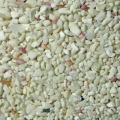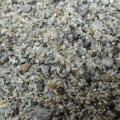1
Sand can be found almost anywhere. Lakes, rivers, beaches, ponds, and even backyards are all places where you can find sand. When you have collected sand from a location, check there again - most places have more than one color of sand.
While collecting, you will need plastic baggies (in which to store the sand), and a permanent marker (to label the baggies). Label each bag with your name, the date, and the location where the sand was found. Be as specific as possible (perhaps recording latitude and longitude if you have a GPS receiver). Some people prefer to use clear pill bottles - ask nicely at your local pharmacy for enough to hold your collection.
Be sure to collect enough sand to share with others. If you are working on this honor with your club, 30 colors should not be very difficult to achieve if everyone collects enough sand for everyone else.
Get started, explorer!
2
Sand is a naturally occurring granular material composed of finely divided rock and mineral particles. As the term is used by geologists, sand particles range in diameter from 0.0625 (or 1⁄16 mm) to 2 millimeters. An individual particle in this range size is termed a sand grain.
There are three major types of sand:
- Terregenous
- This type of sand is eroded from rocks (sedimentary, volcanic, and crystalline), and is generally transported by water. Most sand is of this type.
- Carbonate
- This type of sand has organic origins, being made from ground sea shells, corals, and other marine sources.
- Pyroclastic
- This type of sand is created when volcanoes erupt and blow their ash (pyroclastic sand) into the atmosphere.
3
Sand is formed through two primary processes - Physical and Chemical.
Physical sand formation includes weathering (natural erosion of parent material via wind, wave, temperature or organic breakdown), crushing (a more direct way of breaking parent material into smaller portions), and through pyroclastic means (formed from volcanic activity).
Chemical sand formation is usually through precipitation, often when calcium carbonate or silicate in solution forms around some smaller particle and settles out in the form of ooliths.
The mineral content of sand reflects its parent material. Typical minerals include quartz and other silicates, feldspar, micas, and calcium carbonate.
4
Sand is composed of inorganic material, even if it had biogenic origins (shells, coral, diatoms, foraminfera). Soil, however, is made up of sand, silt, clay, and organic humus (broken down plant and animal matter).
5
Shape
The shape of a grain of sand can tell us about its history. Rounded grains are those which are relatively old, the rounding being caused by the grain getting blown around by wind or pushed around by water. Grains with more angular surface are relatively young, not having had time to get rounded by the forces of nature.
Sand shape can be classified using a Wadell Scale, which uses two features to classify each grain: Angularity and Sphericity. The angularity axis considers if the grain has sharp angles or if it has been rounded through abrasion. The sphericity axis considers how round or oblong an item is, and ranges from high sphericity (nearly a ball) to low sphericity (perhaps a rod, curve, or other shape).
Surface
The surface texture of grains may be polished, frosted, or marked by small pits and scratches. This information can usually be seen best under a binocular microscope, not in a thin section. If sand grains have a polished appearance, it usually reflects their origin in a water environment (rivers, streams, lakes or the ocean). Sand grains with a frosted appearance are usually the product of a windy environment.
Grain Fracture
In the field of mineralogy, fracture is a term used to describe the shape and texture of the surface formed when a mineral is broken. Minerals often have a highly distinctive fracture, making it a principal feature used in their identification.
Conchoidal fracture
Conchoidal fracture is a curved breakage that resembles the concentric ripples of a mussel shell. It often occurs in amorphous or fine-grained minerals such as flint, opal or obsidian, but may also occur in crystalline minerals such as quartz. Subconchoidal fracture is similar to conchoidal fracture, but not as curved.
Earthy fracture
Earthy fracture is reminiscent of freshly broken soil. It is frequently seen in relatively soft, loosely bound minerals, such as limonite, kaolinite and aluminite.
Hackly fracture
Hackly fracture (also known as jagged fracture) is jagged, sharp and uneven. It occurs when metals are torn, and so is often encountered in native metals such as copper and silver.
Splintery fracture
Splintery fracture comprises sharp elongated points. It is particularly seen in fibrous minerals such as chrysotile, but may also occur in non-fibrous minerals such as kyanite.
Uneven fracture
Uneven fracture is self descriptive. It occurs in a wide range of minerals including arsenopyrite, pyrite and magnetite.
Grain Size
Grain size, also called particle size, refers to the diameter of individual grains of sediment. In grading sand, the Wentworth Scale is often used. Sand particles ranging from 1/16 to 1/8 mm are considered Very Fine. Those from 1/8 to 1/4 mm are Fine. 1/4 to 1/2 mm are Medium. 1/2 to 1 mm are coarse. And those from 1 to 2 mm are considered very coarse. Various grades of Gravel are larger than sand, silt and clay are smaller than sand.
| Grain Size | Description |
|---|---|
| 1/16-1/8mm | Very Fine |
| 1/8-1/4mm | Fine |
| 1/4-1/2mm | Medium |
| 1/2-1mm | Coarse |
| 1-2mm | Very Coarse |
6
6a
Glacial sand is sand produced by the action of a glacier grinding the rock over which it passes. Glacial sand may be used in construction or as fill.
6b
Sand composed primarily of calcium carbonate or limestone. Calcareous sand may be used in construction, as road fill (particularly in beach nad island environments where it may be plentiful), and as a base material on gold course putting greens and some athletic fields.
6c
Quicksand is a colloid hydrogel consisting of fine granular matter (such as sand or silt), clay, and salt water. In the name "quick" does not mean "fast," but "alive" (as in the expression the quick and the dead).
6d
Glass sand is sand with low iron content, and high silica (SiO2) content. This type of sand is ideal for glass making.
6e
Molding sand, foundry sand, or green sand is sand that when moistened or oiled tends to pack well and hold its shape. It is used in the process of sand casting.
6f
Sand can be used as an abrasive material for polishing materials. Several different grain sizes, gradually growing smaller, are used to polish surfaces.
6g
Building sand is used for making concrete. Sharp sands (with angular surfaces) are preferred.
6h
Sand can be used to filter water or other liquids. A media filter is a type of filter utilizing a bed of sand, crushed granite or other material to filter water for drinking, swimming pools, aquaculture, irrigation, stormwater management and other applications.
6i
Furnace sand is used for lining the floor of industrial furnaces which are used for processing molten metals (such as steel).
6j
Sand created by the wave action of a lake. A prime example would be the Indiana Dunes National Lakeshore in northwest Indiana. Depending on its mineral origin, lake shore sand is often used for foundry work.
7
Using a hand lens or a microscope, examine the sand grains, looking for the features described in requirement 5 (shape, surface, grain fracture, and grain size). You can also note its color and its variability are all the grains the same size? Are they all the same shape, or are there big differences from one grain to the next?
1. Port Melbourne, Australia. Primarily mineral origin.
2. Bar Harbor, Maine. A mixed mineral and biogenic sand.
3. Sea Point, Capetown, Southafrica. Primarily biogenic.
4. Mona Island, Puerto Rico. A biogenic sand.
5. Soesogakk, Jeju, South Korea. Volcanic origin.
6. Mustang Island, Texas. An example of very fine sand.
7. Lake Champlain, Vermont. An example of a very coarse sand.
8. Columbia River, Oregon. An example of riverine sand.
8
I will surely bless you and make your descendants as numerous as the stars in the sky and as the sand on the seashore. Your descendants will take possession of the cities of their enemies
- Stone is heavy and sand a burden,
- but provocation by a fool is heavier than both.
- How precious to me are your thoughts, O God!
- How vast is the sum of them!
- Were I to count them,
- they would outnumber the grains of sand.
- When I awake,
- I am still with you.















